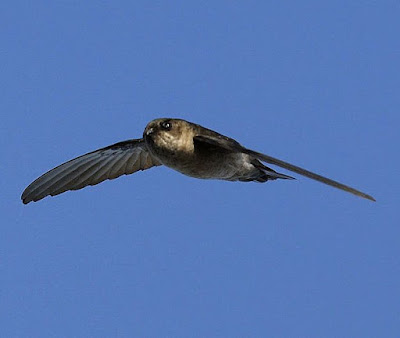 |
| Photo by Kévin Le Pape (Wikipedia) |
Common name:
Mascarene swiftlet (en); andorinhão-das-Mascarenhas (pt); salangane de Mascareignes (fr); salangana de las Mascareñas (es); Mauritiussalangane (de)
Taxonomy:
Order Apodiformes
Family Apodidae
Range:
This species is endemic to the islands of Réunion and Mauritius, in the Indian Ocean.
Size:
These birds are 10-11 cm long and weigh 9-9,5 g.
Habitat:
The Mascarene swiftlet breeds in lava tunnels, been found foraging over a wide range of habitats including moist tropical forests, grasslands, scrublands, second growths and arable land.
Diet:
They forage in flocks, mainly taking flying insects on the wing. Among their prey are flies, flying ants, beetles, bugs, barkflies and spiders.
Breeding:
Mascarene swiftlets can breed virtually all year round. They nest in colonies within lava tunnels, with each pair building a bracket-shaped nest made of lichen filaments held together with saliva. The female lays 1-2 eggs which are incubated for 21-23 days. The chicks fledge 45-55 days after hatching.
Conservation:
IUCN status - NT (Near-Threatened)
This species has a relatively small breeding range and the global population is estimated at 6.000-15.000 individuals. Over recent years, the population on Réunion has increased substantially, whilst that on Mauritius has declined, making it difficult to judge the overall population trend. The main threats affecting this species are nest collecting for bird's nest soup and vandalism of caves. Tourism activities such as canyoning and caving may also cause disturbance to breeding colonies.





No comments:
Post a Comment